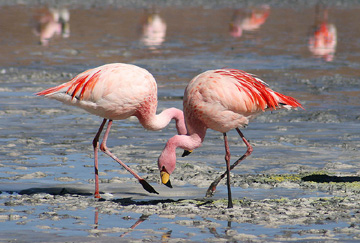The brightly colored flamingo gives credence to the old saying, “you are what you eat.” In the flamingo’s case, though, there’s a slight change: you are the color of what you eat.
Flamingoes are found along tropical coastlines in much of the world. Depending on the species, they can grow up to four or five feet tall, and live for 20 years. They usually live in colonies of hundreds or even thousands of birds.
 Flamingos in Bolivia. Credit: Wikipedia/Valdiney Pimenta
Flamingos in Bolivia. Credit: Wikipedia/Valdiney PimentaSuch large groups create a spectacular sight, because flamingoes are colored in brilliant shades of pink, orange, and red. But they’re not born that way — young flamingoes are gray. Instead, the graceful birds eat their way to those beautiful colors.
A flamingo uses its long bill to scoop up mud and water. Hard structures inside the bill, as well as “bristles” on its tongue, filter out food, including algae, shrimp, and mollusks. These creatures contain pigments known as carotenoids. They’re similar to the orange pigments in carrots, or the red in watermelon.
Enzymes in the liver dissolve the pigments, which are then pumped through the bird’s body. The pigments collect in the feathers, head, and legs. The American flamingo is the brightest of all, colored in vivid red and pink.
The color doesn’t last forever, though. If a flamingo doesn’t eat foods that are rich in carotenoids, it turns pale pink or even white. So zoos have to make sure to include high doses of these pigments in the special pellets they feed flamingoes — making sure these beautiful birds remain eye-catching attractions.

